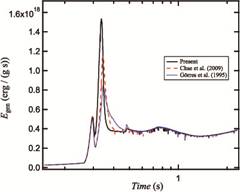The proton resonant properties of compound 22Mg nucleus have been investigated by researchers of nuclear astrophysics group at the Institute of Modern Physics, Chinese Academy Sciences (IMP) using resonant elastic scattering of 21Na+p. Here an inverse kinematics method was utilized, that is, a 21Na radioactive ion (RI) beam bombards a proton target. Researchers of IMP performed the experiment by using CRIB at the Center for Nuclear Study, the University of Tokyo. An 89 MeV 21Na RI beam was produced at the CRIB and bombarded an 8.8 mg/cm2 thick CH2 target. The recoiling protons were measured at scattering angles of qc.m.»175° and 152° by three DE-E silicon telescopes. The excitation function was obtained with a thick-target method over energies Ex(22Mg)=5.5 - 9.2 MeV. For the first time, the Jp values for ten states above the alpha threshold in 22Mg were experimentally determined in a single consistent measurement. Researchers made three new Jp assignments and confirmed seven of the ten tentative assignments in the previous work. The 18Ne(a, p)21Na reaction rate was recalculated, and the astrophysical impact of new rate was investigated through one-zone postprocessing x-ray burst calculations. It was found that the 18Ne(a, p)21Na rate significantly affected the peak nuclear energy generation rate and the onset temperature of this breakout reaction in these phenomena. The stellar 18Ne(a, p)21Na reaction studied was thought as a breakout reaction from the Hot CNO cycle (HCNO) to rapid proton capture rp-process occurred in Type I x-ray bursts. The present new rate will help people very much to understand the energy production, nucleosynthesis, as well as isotope abundances in such high temperature and high density stellar environment. The result has been published in Phys. Rev. C 88 (2013) 012801R (Rapid Communications). 
Fig.1 Experimental center-of-mass differential cross section for resonant elastic scattering of 21Na+p at a scattering angle of qc.m.»175°. It also showd a best overall R-matrix fit. (Image by IMP) 
Fig.2 Nuclear energy generation rates during one-zone XRB calculations. (Image by IMP) |

